Tuning the Timpani
Although many people consider the timpani to be a “drum,” it is actually a MELODIC instrument because you can play pitches (whereas the snare drum, bass drum or cymbals have no definite pitch). Use the following steps to learn the
proper technique to tune the timpani:
Step One: Knowing the Drums
The first and most obvious step to tuning the timpani is to know what size timpani will reach the desired pitch. Spend some time memorizing these pitch ranges:

Step Two: Hearing and Singing the Pitch
The biggest problem that most percussionists have with tuning the timpan i is being able to HEAR and SING the pitch! Start with a pitch pipe and see if you can sing or hum various pitches (EVERY good percussionist should own, or have
access to, a pitch pipe or tuning fork). You don’t have to have a great singing voice to sing a pitch, but you will have to put some effort into it. If you can’t sing a pitch, then tuning the timpani is going to be very difficult at best!
My Easy, Never Fail (but not too sophisticated) Approach to Tuning
I have found that the easiest method of getting my students to hear the pitch on a timpano is to approach it like a bad country western singer! Sing the lowest of these two pitches, then “scoop” up to the second pitch.

Now, with the pedal at the bottom ran ge of the timpani, hit the drum. Immediately after you strike the drum ONCE, GRA DUALLY push the pedal up. If you can work the pedal smoothly and slowly, you should be able to hear when the timpano reaches the desired pitch. Try to tune the 29” and 26” timpani to the second note by using this approach.
Decide which drums you should use to tune these following notes, then give it your best shot.

DIRECTORS: avoid tellin g the students “A little higher” or ”A little lower!” If the student misses the pitch, start over from scratch!
Young percussionists will often guess at the pitch and be satisfied when you doing the “fine tuning” for them!
More Tuning Exercises
Play this next exercise on the keyboard, then sing it. Tune a B on the 29” timpano and see if you can play this tun e just by moving the pedal! Take a slow tempo and try to make your pedal movements as quickly as possible in order to get a definite pitch from each note.

Tune an “F” on the 29” timpano, and a “C” on the 26” timpano for the next exercise. Start very slowly and see if you can
match each note with the pitch pipe before attempting to play it in tempo (it also helps to know where whole steps and half steps are located in the major scale so that y ou’ll know how much pedal action to use).

Muffling the Timpani
It is often necessary to stop the timpani from vibrating during a piece of music. In order to do this without “slapping” your hands on the drum, you must learn the proper technique for quick and SILENT muffling.
First, hold the stick with the thumb and index finger ONLY. Exten d the remaining three fingers out. Now gently touch the drum head (near the beating spot) with the little finger, then rapidly roll the other fingers on to the head while you
press down . If the volume level is mezzo forte or forte, you may need to use the HEEL of your hand in addition to the fingers to stop the sound en tirely.
Practice muffling the drum on the rests in this exercise. Each note should be given its exact value, and no sound should occur in the rests. Start with a very slow tempo (quarter = 80), then speed up as you get more accustomed to muffling
techniques.
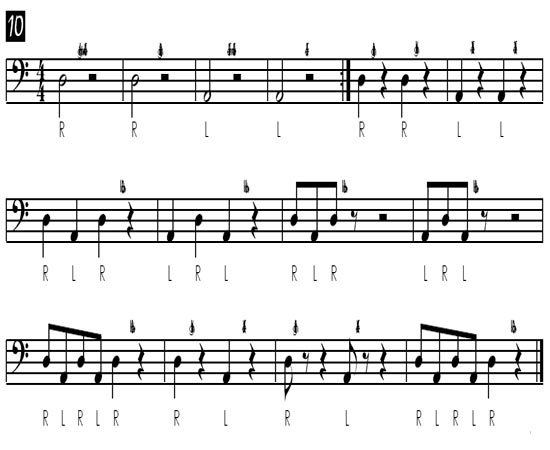
Playing Rolls on the Timpani
The purpose of the roll on timpani is to sustain an even sounding tone. A win d player does this by blowin g air through the instrument, a string player does it by drawing the bow across the string. Since the sound of the timpani note decays
as soon as it is hit with the mallet, we must sustain a tone by rapidly striking the drum. To accomplish this, relax the wrists as much as possible and play with quick, EVEN strokes single strokes (never play bounce rolls on the timpani).
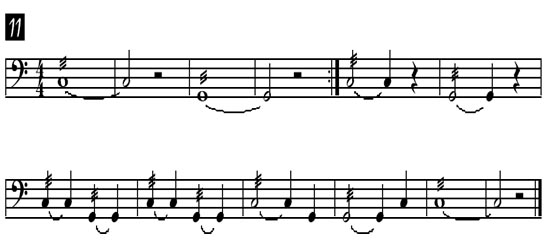
You may notice that it is easier to produce a nice sounding roll on the lower drum. That is because a loose timpani head has a slower VIBRATION speed than a tight head. In order to keep the head vibrating, you can play with a slower roll speed. Try tuning the smallest timpani to the highest pitch and see how fast you must roll to keep the vibrations going!
The Passing Roll
When playing a passing roll (or slur), it is necessary to pass from on e drum to the other without a break in the roll. Just like in the passing stroke exercises, you must always shift to the next drum with the INSIDE mallet first, avoiding
a cross stroke. Try this 16th note exercise first, then speed it up until the 16th notes become rolls.

Of course, you may not be able to always play an even number of strokes on passing rolls. In this next exercise, try to move from one drum to the next as SMOOTHLY as possible, without any breaks in the sound.
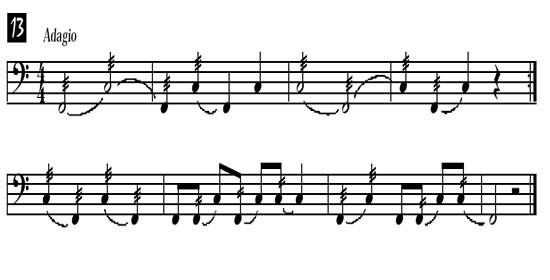
Timpani Etudes
Read the key signature when finding out which two notes to tune in this etude. Remember to stop all sound possible on each rest by muffling as quietly as possible. Follow the sticking when it’s provided for you.
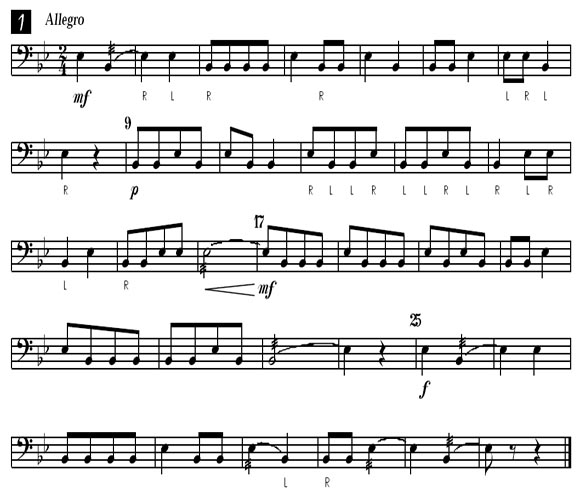
This short etude includes some staccato notes (measure 15 and 16). When a dot is placed above or below a note, play the drum, then muffle as quickly as possible.
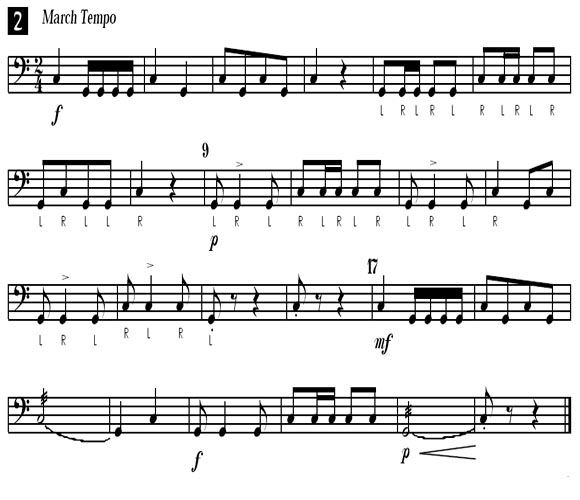
Accurate and silent muffling is extremely important in this slow etude. While all sound should stop on each rest, make sure that each note gets its full value.
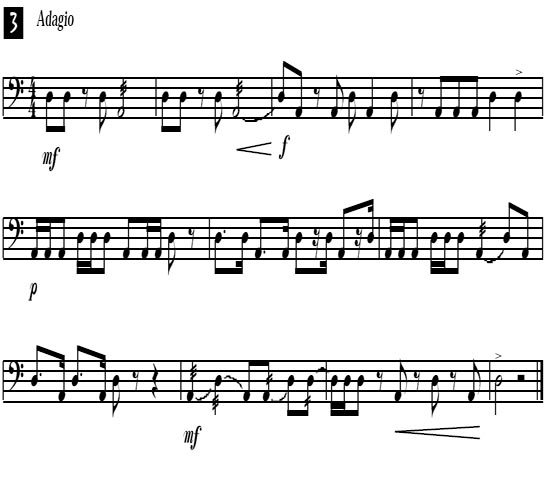
This etude includes a couple of quick tuning changes (meas. 12 and 20). Practice the tuning change several times to get used to the “foot action.”
While it might be easier to play this etude with 3 drums, GREAT TIMPANISTS will be able to play it on two!

This etude is much more difficult and will take a few weeks to master. Have your teacher explain: D.C. al Coda, rolls, and Tempo
I. Try to play this etude with a feeling of one beat to the measure.

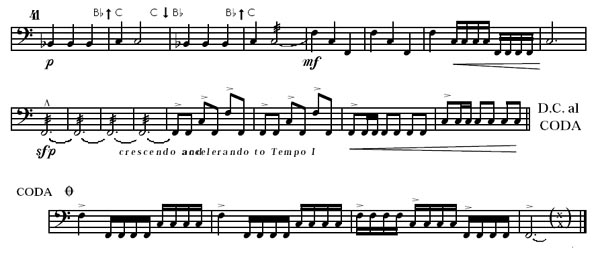
Copyright © 1996 by Mark Wessels Publications
Mark Wessels Publications • 433 Derby Lane • DeSoto, TX 75115
Related posts:
Short URL: https://trendmarching.or.id/read/?p=805



